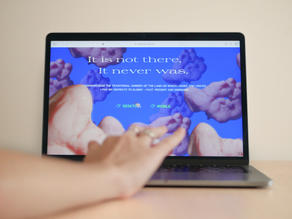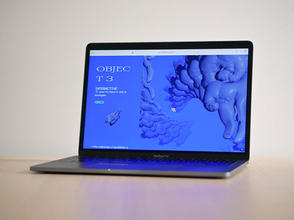' I T I S N O T T H E R E . I T N E V E R W A S '
O N L I N E S O L O E X H I B I T I O N
M A Y 2 0 2 2
N E X T D O O R A R I , B R I S B A N E , (M E A N J I N) A U S T R A L I A.
'It is not there, It never was' is an interactive website created during a six week online residency that explores shape and form in a digital setting.
The objects that appear display the symbiotic relationship found between synthetic and organic worlds.
The experience gently invites the user to interact with objects in their digital settings, summoning a sensation of fun and calm that soothes the senses.
These forms are initially generated in a virtual space, after being augmented and distorted, the artefacts are plucked when deemed aesthetically ripe, their essence is captured physically by the artist.
They are conjured into the physical realm with the creation of sculptures, paintings or functional objects. These items may find their way back into the digital world, making the practice a cyclical process with its outputs continuously evolving.
Technology acts as the muse of the creative process.
The artworks are expressive responses, relics from a post-digital landscape displaying the relationship between digital and biological realms.
Documentation of desktop images and desktop videos by: Kimberly Stokes.
(All images are Artists own)

























BRB, my brain is tingling.
Exhibition essay by: Olivia Trenordon
What’s the opposite of crashing and burning?
Whatever it is, that describes Cornelia van Rijswijk’s (she/her) newest body of work.
Van Rijswijk’s stimulating 3D-renderings of fleshy, tactile, other-worldly forms, in short, are incredible. The artist captures the limitless boundaries of imagination, exposing layers on layers of careful and articulate responses to living in a tech-heavy world. Utilising the same technological means that she is commenting on, van Rijswijk has created a way to exist in an online world without falling victim to it.
Each page of the interactive platform peels back, exposing more space to explore and experiment with a chaotic and whimsical online world. As the curator of this playscape, van Rijswijk plays God with her objects. Deciding when, how and in what form they will exist, how far she will push them, the extent of her pulling and twisting of their reality.
As I write this, I am calmed by the isochronic tones playing in my web browser tab. Even without viewing van Rijswijk’s work, her digital sculptures permeate my frontal lobe. My brain is tingling. There is something cosmic about the space that has been created here. It is simultaneously boundless and confined by the parameters that the viewer assigns to their experience. As your cursor manipulates the fleshy beings, you are tugging and pulling at their form, materiality and function. Amorphous yet material, synthetic yet seemingly organic, digital means are used to carve out the sensation of the physical object without ever leaving the digital world.
“It is not there, it never was.” The title of this exhibition captures the transitory nature of van Rijswijk’s work. Both endless and enduring, this liminal space traps you in it, forgoing time and place to forge a somehow nostalgic yet unfamiliar metagalaxy of ones and zeros. The ephemeral nature of these digital beings boggles my mind. Here, they exist in the digital plane of Nextdoor ARI. But, if deleted, what state does van Rijswijk’s work occupy? This is the indisputably perplexing quality of digital forms. Do the objects exist because we have perceived them? Do they exist only in relation to the viewer's perception of them? If a nuclear apocalypse struck right now, and the world as we know it was permanently destroyed, does van Rijswijk’s work still exist? Does it exist in memory or in reality? Both? Neither?
Such is the mystery and beauty of van Rijswijk’s work. The artist sculpts the objects, presents them to the world and must patiently wait to see how the objects exist in their viewers’ psyche. We, as participants in the world that van Rijswijk has created, play a part in the evolution of the object, morphing them bit by bit by our own interpretations.
Notes on Accessibility:
Art writing is infamous for being overly complex and filled with jargon. Good art writing is easily communicated and understood. Writing about art, which is often multi-faceted and conceptual, whilst utilising language that is accessible requires a bit of tight-rope walking. To try and close the gap, the author has provided some definitions for some terms that may not be familiar to all.
Metagalaxy: the complete system of galaxies; the Milky Way and all the surrounding galaxies.
Materiality: the quality within the work that extends beyond the physical matter of the object to encompass all the relevant aspects of its existence, including how the viewer interprets it as an object, despite not being able to hold, touch or physically manipulate the object.
Playscape: the art as a playground. an open invitation to interact with the objects to shape and mould the landscape which, in this context, is digital.
